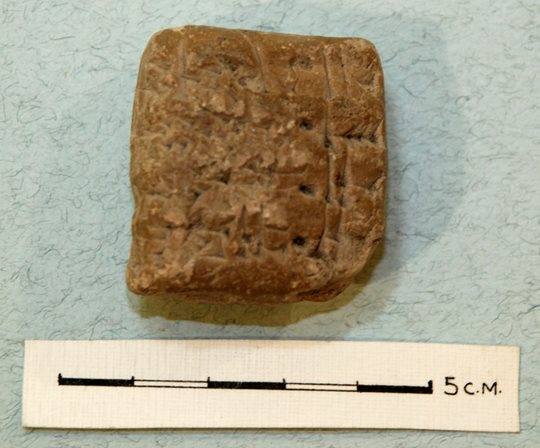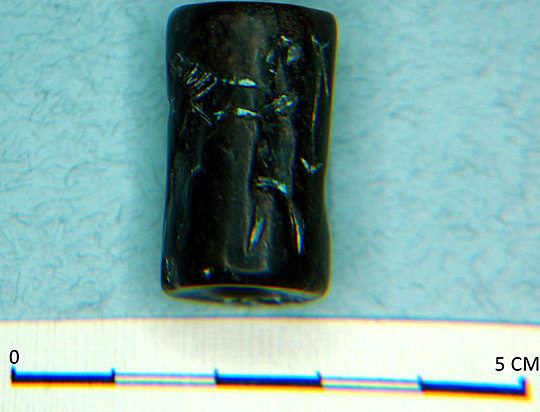c. 3000 BC
Cuneiform Tablets: the Genesis of Documentation
Today we compile inventories and record data on computers using database programs. Yet the origins of documentation date back about 5,000 years to the development of the cuneiform script in Mesopotamia.
By Sharon WeadickCuneiform tablets are not particularly rare archaeological objects, but they are extremely important. The National Museum of Ireland has a small collection of cuneiform tablets in its reserve collection. It is particularly fitting to showcase some of these tablets on this documentation related forum as the purpose for which they were developed was to record information.
Description
The most common artefacts containing cuneiform script are tablets. However, cuneiform script was also incised onto cylinder seals, the Cyprus Cylinder being perhaps one of the most impressive examples. Clay was the preferred medium but some stone cylinder seals have also been found. The script was usually applied to damp clay then fired in a kiln to produce buff orange-pink coloured tablets. Some tablets were also enclosed in clay envelopes.
The Cuneiform Tablets in the Museum’s Reserve Collection
There are thirteen cuneiform tablet fragments, one cylinder seal and one cuneiform tablet cast in the Museum’s reserve collection. This is a tiny collection when compared to the 130,000 texts and fragments of cuneiform tablets that make up the British Museum’s collection. The majority of our cuneiform artefacts appear to have been donated or purchased by the Museum in the 1930s and 1940s. Six of the tablets are part of the Greene collection which was donated to the Museum in 1939 by Mary Greene from Bray, Co. Wicklow. There is very little detail to be found in the Museum's registers regarding the other cuneiform artefacts or how the donors came to be in possession of them. For example one entry reads: 1944:849. Cuneiform tablet from Ur of The Chaldees, Mesopotamia. Presented by Bean Uí Bhrolcháin, Clontarf, Dublin.

What is Cuneiform Script?
Cuneiform script dates back to c. 3000 BC, making it one of the earliest known writing systems. It was developed by the Sumerians in Mesopotamia, now modern day southern Iraq. At that time there was rapid growth and prosperity in the region and officials required a system for recording bureaucratic details. Initially, the recording system took the form of pictographs etched onto clay tablets using a wedge-tipped stylus/tool.
Over time, the pictographs were replaced with more abstract, wedge-shaped characters. It is from these distinctive characters that the script gets its modern name, from Latin cuneus meaning ‘wedge’. Text was organised in horizontal rows running from left to right. Another significant advancement was made when cuneiform evolved into a phonetic writing system – the characters developed to represent specific sounds so that language could be recorded. From about 4,000 years ago the use of cuneiform script was expanded to record astronomical, medical, magical and literary texts. Sagas such as The Epic of Gilgamesh, which would previously have been recited from memory, now came to be written down. Cuneiform was in use for over three millennia, and during that time it was adopted throughout the Middle East and adapted to record up to fifteen different languages.

Deciphering Cuneiform
Once cuneiform script fell out of use the knowledge of how to decipher it was also forgotten. It was not until the middle of the nineteenth century that several scholars - Henry Creswicke Rawlinson, Edward Hincks, Julius Oppert and William H. Fox Talbot - finally managed to unlock the script again. To date only a small percentage of cuneiform tablets have been translated. However, those that have been translated reveal a wealth of information about the ancient civilisation of Mesopotamia. Translating cuneiform script is a laborious, complicated but exciting task. Apparently George Smith, who translated the Flood Tablet in 1872, is said to have been so euphoric when he discovered what its contents were that he stripped off.
To Conclude
Cuneiform tablets are undoubtedly a valuable part of any museum’s collections. They go beyond being mere archaeological objects as they are also historical documents and literary texts. The Museum is fortunate that Klaus Wagensonner of the University of Oxford has undertaken the task of translating the cuneiform tablets in our collection. We look forward to the publication of his research. In the meantime we have yet to hear if any of them are so exceptional as to have driven him to a state of undress unlike his nineteenth century colleague!
Learn More
These objects are part of the Museum’s reserve collections and are not on display. Related objects are on display in gallery two of “The Treasury” exhibition in the National Museum of Ireland – Archaeology on Kildare Street.
References
MacGregor, N. (2012) A history of the World in100 objects. London.
Spar, Ira (2004) The Origins of Writing. Available at https://www.metmuseum.org/toah/hd/wrtg/hd_wrtg.htm [Accessed 29 march 2016].
With thanks to Dr Nessa O'Connor, Assistant Keeper Grade 1, Irish Antiquities Division.
Location:
Cuneiform Tablets: the Genesis of Documentation is located at:
In Storage
Previous artefact:
Next artefact:
